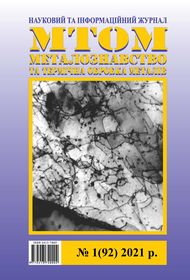Transition from engineering strain to the true strain in analytical description of metals hardening
DOI:
https://doi.org/10.30838/J.PMHTM.2413.230321.66.736Abstract
Purpose of the work is related with the impossibility of correctly estimating the strain hardening of metals (alloys) in the area of their large total deformations due to absence of additivity in the traditionally used value of engineering strain g, its nonlinear change in the area of large values, and absence of data in the technical literature Hall-Petch coefficient Ai for logarithmic true deformations, which led to the task of correct transition from the values of the engineering strain 0 < g < 50...60 % to the value of the true logarithmic strainn 0 < e < 1...3. Methodology.
The theoretical analysis of the regularities of deformation hardening of metals (alloys) from the engineering strain is carried out, the transition from engineering to logarithmic ("true") strain of metals (alloys) by analytical representation of metal hardening graphs as a function of logarithmic (true) strain. in contrast to the degree of engineering strain is presented. Originality. Analytical expressions are presented that allow the use of known theoretical data on the strain hardening of metals (alloys) at small (50...60 %) total engineering strains g during cold pressure treatment to transition to logarithmic (true) strain e with large total deformations. Practical value. The obtained mathematical expressions allow to use the accumulated in the technical literature experimental data on the hardening of metals and alloys with small engineering strains in the processes of cold processing of metals (alloys) by pressure to determine the hardening with large total logarithmic (true) strains. These data can also be used to solve metallophysical problems of metal processing by pressure associated with large total compressions.
Keywords: cold forming of metals and alloys; hardening; degree of deformation

Downloads
Published
Issue
Section
License
Authors that are published in this journal agree to follow the conditions:
Authors reserve the right to the authorship of his work and cede the right to the journal of first publication of this work on conditions of the license under the Creative Commons Attribution License, which allows others to distribute it freely with the obligatory reference to the author of the original work and the first publication of the work in this journal.
